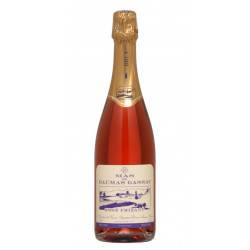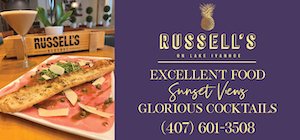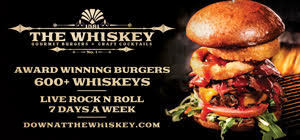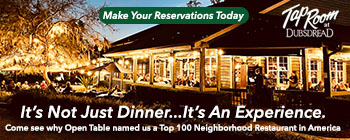Editor’s note: The article is by guest columnist Erin Allport. Wine prices are from Wine on the Way.
 I had the opportunity recently to have lunch with Samuel Guibert, winemaker and owner, of the French winery Mas de Daumas Gassac. I have been drinking the wines from Gassac for years and always enjoy them. The wines are affordable and the quality is very high so they are on my “go to” list for everyday drinking as well as bringing something fun and new to a friend’s or dinner with family. Some of my most fun wine memories have involved the wines from Gassac. They just make you happy. The history of this winery is exciting and interesting. I also really love their website, it’s very engaging and they actually re-wrote it in English instead of just “google translating” the page.
I had the opportunity recently to have lunch with Samuel Guibert, winemaker and owner, of the French winery Mas de Daumas Gassac. I have been drinking the wines from Gassac for years and always enjoy them. The wines are affordable and the quality is very high so they are on my “go to” list for everyday drinking as well as bringing something fun and new to a friend’s or dinner with family. Some of my most fun wine memories have involved the wines from Gassac. They just make you happy. The history of this winery is exciting and interesting. I also really love their website, it’s very engaging and they actually re-wrote it in English instead of just “google translating” the page.
Mas de Daumas Gassac is considered to be the Languedoc’s “first growth.” In the 1970’s Samuel’s parents were looking to purchase a property as a home away from the city life of Paris. His father, Aime Guibert, was a Parisian glove manufacturer and had no plans of making wine. They stumbled across an old, abandoned farmhouse owned by the Daumas family that had been shaped by the flow of the Gassac. Their good friend Henri Enjalbert visited them and while taking a walk around, he noticed that there was a great combination of red glacial soils beneath the garrigue, the low-growing vegetation on the limestone hills, cool nocturnal climates and altitude that would be great for viticulture. Serendipitously, Emile Peynaud (known as the forefather of modern oenology) planted the first vineyard of un-cloned Cabernet cuttings he brought from Bordeaux.
In 1982 the wines were first distributed to the US by importer Kermit Lynch. It wasn’t until 2004 that they decided to directly import the wines and grow the brand. We only get a fraction of the wines in the US. A lot of the grapes they grow, we hardly hear of and thus, they probably wouldn’t do as well as the seven wines they import. Plus, we are the only country that has to have “label approval” by the ATF so it’s much more cost effective (and better on our wallets) to focus on select wines.
If you are a wine lover, you may have seen the 2004 documentary Mondovino. The film explores the impact of globalization on the various wine-producing regions, and the influence of critics like Robert Parker and consultants like Michel Rolland in defining an international style. It pits the ambitions of large, multinational wine producers, in particular Robert Mondavi, against the small, single estate wineries who have traditionally boasted wines with individual character driven by their terroir. In fact, it was Mondavi that tried to purchase the protected forest of the Languedoc in the 1990’s. The local mayor tried to “sell” the village on the fact that this was a wine investment, however, the people of the village revolted and suffice it to say, the mayor was very unpopular and pushed out of office.
In the near future look for a Pinot Noir from Gassac that is set to release soon in select markets. Also, there will be some special releases of Library vintages; I really hope these wines make it to Florida. Getting to drink older vintages, to me, is drinking history. I asked Samuel if any of his children are interested in the family wine business. Luckily, he has four brothers so surely one of their kids will want to be part of the winery. Although he said they say in France, “The first generation creates, the second generation grows and the third loses it all.”
Wines tasted:
2013 Moulin de Gassac Picpoul de Pinet ($15) – Picpoul de Pinet is a indigenous varietal of the Languedoc. This wine is a very pretty wine. It has a fine mineraltity and lots of citrus notes with a long finish. This wine is perfect for anyone wanting to branch away from Pinot Grigio and try something new.
 NV Mas de Daumas Gassac Rose Frizzant ($24) – oh how I do love bubbles! This sparkling wine is really fun and delightful. It’s a rose made from 90% “free run” Cabernet Sauvignon and 10% Petit Manseng. Samuel recommends serving this wine with three intentions: “to quench thirst, indulge the taste buds, and banish gloom.” In Florida we don’t have too much gloom but we can definitely quench our thirst with this wine in the summer.
NV Mas de Daumas Gassac Rose Frizzant ($24) – oh how I do love bubbles! This sparkling wine is really fun and delightful. It’s a rose made from 90% “free run” Cabernet Sauvignon and 10% Petit Manseng. Samuel recommends serving this wine with three intentions: “to quench thirst, indulge the taste buds, and banish gloom.” In Florida we don’t have too much gloom but we can definitely quench our thirst with this wine in the summer.
2013 Mas de Daumas Gassac Blanc ($48) – a blend of Chardonnay, Viognier, Chenin Blanc, Petit Manseng and other indigenous varietals, this wine is fermented in stainless steel which gives this wine incredible freshness. I hope that they release a library vintage of this wine as it would be great fun to see how this white wine ages.
2012 Mas de Daumas Gassac Rouge ($48) – 80% Cabernet and the rest indigenous varietals, this flagship wine is made in the classic “Medoc-style”. The wine is unique with hints of smoked meats, herbs and dark fruits. It was a great accompaniment to the food at The Pig.
In addition, they also import the Gassac Guilhem Blanc, Rose and Rouge that retails at $9/bottle. These wines are a great introduction to the varietals of the Languedoc without breaking the bank and are always very fresh. You can find the wines from Mas de Daumas Gassac at your local wine retail shops. Production is small so you probably won’t find it at a grocery or big wine retailer. The wines are distributed by Augustan Wine Imports, a division of Premier Beverage. If your local shop doesn’t currently carry them, just show them this article and they’ll know where to begin.










